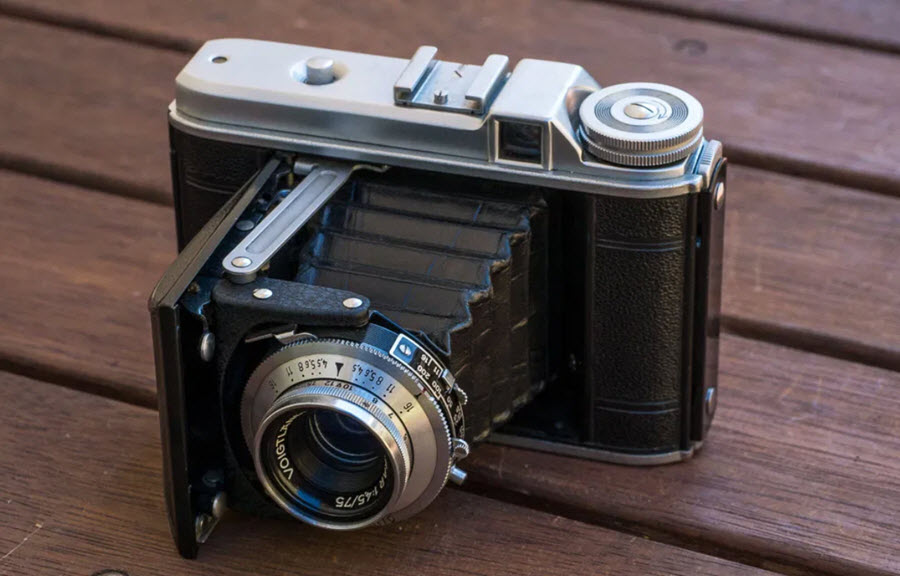Contents
Voigtländer was a manufactorer of optical equipment – including cameras and camera lenses. The roots of Voigtländer goes back all the way to 1756, when the company was founded in Vienna. Even though the company ceased operations in 1972, the name Voigtländer lives on as a brand for a range of photographic equipment sold by Cosina.
The world´s first all-metal camera was the Ganzmetallkamera; a daguerreotype camera called No. 84 made by Voigtländer & Son in Vienna in 1840. Revolutionary for its time, it made it possible to reduce exposure time to roughly one minute. An original Ganzmetallkamera is exhibited at the Deutsches Museum in Munich, and a replica can be seen at the Swedish National Museum of Science and Technology in Stockholm.
Voigtländer was also a technology leader in the field of photography equipment for several decades of the 20th century, and the first manufacturer to introduce a number of new features that later became commonplace. They did, for instance, began selling a zoom lens for 35 mm still photography in 1959 (the (36–82/2.8 Zoomar) and a 35 mm compact camera with built-in electronic flash in 1965 (the Vitrona).

History
Background
Johann Christoph Voigtländer was born in Leipzig in 1732, where his father was a carpenter. Voigtländer moved to Vienna in 1755 and worked in Meinicke´s workshop for mathematical instruments from 1757 to 1762.
Foundation
Johann Christoph Voigtländer founded the business Voigtländer in Vienna in 1756. At this point in history, his business made mathematical instruments, optical instruments, and precison mechanical products, and the product range included things such as opera glasses and optical measurring equipment.
Early years
In 1763, Empress Maria Theresa of Austria granted Johann Voigtländer a Shutzdekret (“Protection Decree”) on the “making of mathematical instruments and on an unspecified number of workers”. This allowed Voigtländer to establish a workshop with staff and sell his products without much competition.
A few years later, Johann Voigtländer invented two important tools:
- A linear device for natural and tapered gauges
- A circular device for astrolabes, cartography, etc.
In 1797, Johann Voigtländer recieved a Landesfabriksbefugnis, which was a type of national commercial license that came with various privileges. Among other things, Voigtländer was now allowed to establish branch sales offices in all major cities of the Austrian Empire.
A family business
Johann Voigtländer died in 1797, but the business survived in the hands of his widow and their children (three sons and one daughter).
Early photography optics and cameras by Voigtländer
When the existence of Daguerre’s process was publicly announced, without details, on 7 January 1839, it became a huge sensation not just in France, but internationally. Soon, the information had reached Vienna, where Johann Voigtländer´s grandson Peter Wilhelm Friedrich Voigtländer took the first step on a journey that would transform the family business into a leading photographic company.
In 1840, the Voigtländer company built the first Petzval lense, a camera lense that had 22 times the light-gathering capacity of Daguerre’s daguerreotype camera lense from 1839, and a maximum aperture of 1:3.6. The Petzcal lens (also known as the Petzval objective) had been invented in Vienna by the German-Hungarian mathematics professor Joseph Petval, with technical assistance provided by Peter Voigtländer. This was the world´s first photographic portrait objective lens, and it had a focal lenght of 160 mm.
1840 was also the year when Voigtländer created the Ganzmetallkamera; the world´s first all-metalic danguerrotype camera. Soon, the company also began selling photographic plate cameras.
Relocation to Braunschweig
In the 1840s, Peter Braunschweig set up a branch sales office in the city Braunschweig, which had become a central railway hub and also had better connections to German overseas ports than Vienna. He married a local Braunschweig woman, and after the unrest brought on by the Revolutions of 1848, Peter and his family moved from Vienna to Braunschweig and established a production site there. The Vienna facility was kept running until the Vienna works manager died in 1868.
The Knight´s Cross
Peter Voigtländer received the Knight´s Cross from the Austrian Emperor in 1864 and became known as Peter Wilhelm Friedrich Ritter von Voigtländer.
Becomming an Aktiengesellschaft
The business became an Aktiengesellschaft (stock company) named Voigtländer & Sohn AG in 1898.
The trailblazing Voigtländer of the 20th century
In 1923, 99.7% of the company shares were acquired by Schering AG´s photo division, who soon commenced large-scale production of Voigtländer products.
Despite new ownership, Voigtländer´s appetite for innovation was still there in spirit, and became clearly visible again in the 20th century when Voigtländer introduced several groundbreaking products, such as the zoom lense for 35 mm still photography premieerd in 1959 (the (36–82/2.8 Zoomar) and a 35 mm compact camera with built-in electronic flash launched in 1965 (the Vitrona).
Second half of the 20th century
- Schering AG sold their Voigtländer shares to the Carl Zeiss Foundation in 1956.
- Voigtländer Vertriebsgesellschaft was integrated with Zeiss-Ikon 1965. This entity produced cameras until August 1971, whe the Voigtländer factory was closed due to falling sales. The rights to Voigtländer were moved to Optische Werke Voigtländer, an entity jointly owned by Carl Zeiss AG, the camera manufactorer Rollei, and the state of Lower Saxony. Later, Rollei took over all the shares.
- After the collapse of Rollei in 1982, Plusfoto acquired the Voigtländer name. In 1997, the rights to the name were purchased by Ringfoto GmbH & Co who licensed it to the Japanese optics and camera company Cosina.
This article was last updated on: October 5, 2020
